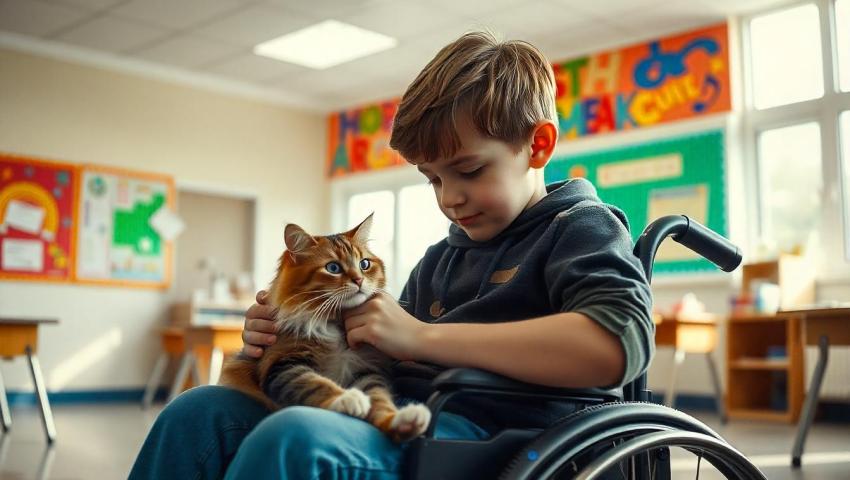
Animal-Assisted Therapy: The Healing Power of Animals
Animal-Assisted Therapy (AAT) is a therapeutic intervention that incorporates animals into the treatment process to promote emotional, cognitive, and physical well-being. This therapy harnesses the bond between humans and animals to enhance the healing process, reduce anxiety, and improve social functioning.
Animal-Assisted Therapy (AAT) is a unique form of therapy that involves the use of animals to assist in the therapeutic process, helping individuals cope with emotional, psychological, and physical challenges. The human-animal bond is powerful, and AAT leverages this connection to improve clients' emotional regulation, cognitive function, and physical health. Common animals used in AAT include dogs, horses, and even smaller animals like cats or rabbits, each chosen based on the needs of the individual and the specific therapeutic goals.
The presence of animals in therapy has been shown to reduce anxiety, lower blood pressure, enhance social skills, and provide comfort during stressful or traumatic experiences. For individuals who may struggle to engage with traditional forms of therapy, such as children with autism or trauma survivors, the non-judgmental and calming presence of an animal can create a sense of safety and facilitate emotional expression.
AAT is used to treat a variety of conditions, including anxiety, depression, PTSD, autism spectrum disorders, and physical disabilities. Whether the goal is to improve mental health, enhance social interactions, or promote physical rehabilitation, animals can play an integral role in the healing process.
Table of contents [Show]
How Animal-Assisted Therapy Works
Animal-Assisted Therapy sessions are typically conducted in the presence of a licensed therapist, who incorporates the animal into the therapeutic process in a structured and goal-oriented manner. The type of animal used, the frequency of sessions, and the specific activities or exercises performed will depend on the individual’s therapeutic needs and goals.
The interactions with the animal can vary greatly, from simple companionship and petting to more structured activities such as walking, grooming, or playing games. In some cases, especially in physical therapy, activities may be designed to encourage mobility, coordination, and physical exercise. For example, equine-assisted therapy (therapy involving horses) is commonly used for individuals with physical disabilities, as the motion of riding can help strengthen core muscles, improve balance, and promote physical coordination.
The psychological benefits of AAT stem from the calming and comforting nature of animals. Research shows that simply being in the presence of an animal can lower stress hormones such as cortisol and increase the production of oxytocin, a hormone associated with bonding and feelings of safety. This makes animals ideal companions in therapeutic settings, especially for individuals who have difficulty opening up emotionally.
Types of Animal-Assisted Therapy
- Canine-Assisted Therapy:
Dogs are among the most commonly used animals in AAT due to their loyalty, intelligence, and ability to form strong emotional connections with humans. Canine-assisted therapy is often used in mental health settings, where therapy dogs help individuals with anxiety, depression, PTSD, and trauma. The simple act of petting a dog can be soothing and grounding, helping clients manage emotional distress and feel more connected to the present moment. - Equine-Assisted Therapy:
Equine therapy, or therapy involving horses, is particularly beneficial for individuals with physical disabilities or those recovering from trauma. The movement of the horse stimulates the rider’s body in ways that promote physical strength, coordination, and balance. Equine therapy is also used in mental health settings to help individuals build trust, develop communication skills, and enhance emotional regulation. - Feline-Assisted Therapy:
Cats can be used in therapeutic settings to provide comfort and emotional support. While less common than dogs, cats’ calming presence can help individuals manage anxiety and improve their emotional well-being. Their gentle nature makes them well-suited for individuals who may be overwhelmed by more active or larger animals. - Small Animal Therapy:
Smaller animals, such as rabbits, guinea pigs, or birds, are sometimes used in therapy with children or individuals who may be intimidated by larger animals. These smaller animals can help promote a sense of responsibility, empathy, and nurturing behavior, while also providing comfort and companionship.
Benefits of Animal-Assisted Therapy
Animal-Assisted Therapy offers numerous benefits for individuals facing a variety of physical, emotional, and psychological challenges. These benefits include:
- Reduced Anxiety and Stress:
The presence of animals can have an immediate calming effect, reducing symptoms of anxiety and stress. Simply petting or interacting with an animal has been shown to lower blood pressure, slow heart rate, and reduce cortisol levels. - Improved Social Skills:
For individuals with autism spectrum disorders, social anxiety, or difficulties with communication, animals provide a non-judgmental and soothing presence that can encourage more positive social interactions. The simple act of caring for an animal can help individuals develop empathy, improve eye contact, and practice social skills in a low-pressure environment. - Enhanced Emotional Regulation:
Animals can help individuals manage and express their emotions more effectively. Whether through the physical act of petting or the emotional bond formed with the animal, clients often find it easier to express their feelings, process trauma, and develop healthier coping mechanisms. - Physical Rehabilitation:
Animal-assisted therapy, particularly equine therapy, is commonly used in physical rehabilitation. The movement of animals like horses or dogs can encourage individuals to improve their physical coordination, balance, and mobility. Additionally, caring for and grooming animals can help individuals regain fine motor skills and develop greater physical strength. - Increased Motivation and Engagement in Therapy:
For individuals who may be resistant to traditional forms of therapy, animals can provide a sense of motivation and engagement. The presence of an animal can make therapy sessions more enjoyable and less intimidating, encouraging clients to participate more fully in the therapeutic process. - Alleviation of Symptoms of Depression and Loneliness:
The companionship provided by animals can reduce feelings of loneliness and isolation, particularly for individuals dealing with depression. Animals offer unconditional love and acceptance, which can boost self-esteem and improve mood. - Trauma Recovery:
For trauma survivors, the presence of an animal can provide a sense of safety and security. Many trauma survivors struggle with trust and emotional vulnerability, but the bond formed with an animal can help them begin to heal. In some cases, animals are used to help individuals with PTSD by providing grounding techniques and reducing hypervigilance.
Applications of Animal-Assisted Therapy
- Mental Health Treatment:
AAT is widely used in the treatment of anxiety disorders, depression, PTSD, and other mental health conditions. Therapy animals provide a calming presence, helping clients manage distressing emotions and develop healthier coping strategies. - Autism Spectrum Disorder:
Animal-assisted therapy has shown positive results in helping children with autism improve their social skills, emotional regulation, and communication abilities. Interacting with therapy animals can help children develop empathy, improve focus, and practice social interactions in a supportive environment. - Physical Rehabilitation:
In physical therapy, particularly equine therapy, AAT is used to help individuals with mobility issues, physical disabilities, or chronic pain. The physical movement of the animal encourages the development of strength, balance, and coordination. - Hospice and Palliative Care:
Therapy animals are often brought into hospice or palliative care settings to provide comfort and companionship to individuals facing terminal illness. The presence of a therapy animal can reduce pain, alleviate anxiety, and improve the overall quality of life for patients in their final stages. - Addiction Treatment:
Animal-assisted therapy is sometimes used in addiction recovery programs to help individuals build emotional resilience, develop coping skills, and improve social functioning. The non-judgmental nature of animals can provide comfort during the difficult recovery process.
Who Can Benefit from Animal-Assisted Therapy?
Animal-Assisted Therapy is appropriate for individuals of all ages, particularly those who:
- Have difficulty engaging in traditional forms of therapy
- Struggle with anxiety, depression, or PTSD
- Have experienced trauma or abuse
- Are on the autism spectrum
- Require physical rehabilitation
- Face chronic illness or terminal conditions
- Experience social isolation or loneliness
Conclusion: The Healing Power of Animals
Animal-Assisted Therapy is a valuable and versatile therapeutic tool that leverages the innate connection between humans and animals to promote healing, comfort, and well-being. Whether helping individuals overcome trauma, manage physical disabilities, or simply provide companionship, animals play an essential role in the therapeutic process. With its wide range of applications and proven benefits, AAT offers an innovative and compassionate approach to therapy that enhances emotional, psychological, and physical health.



